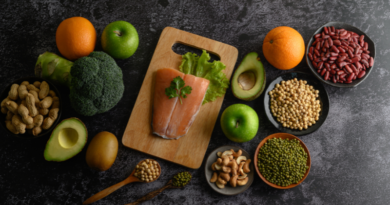10 keystone habits to reduce belly fat
Belly fat, also known as visceral fat, is a common concern for many people. Not only can it make you feel self-conscious, but it can also pose significant health risks, such as increasing your chances of developing heart disease, type 2 diabetes, and certain types of cancer.
The good news is that by adopting healthy habits and making lifestyle changes, you can effectively reduce belly fat.
In this article, we’ll explore 10 habits that can help you shed those extra pounds around your waistline and lead a healthier life.
Table of Contents
1. Prioritize a Balanced Diet
One of the most crucial habits for reducing belly fat is maintaining a balanced diet. Make it a priority to eat whole foods, including fruits, vegetables, lean sources of protein, whole grains, and healthy fats. Avoid processed and sugary foods that can contribute to weight gain. Additionally, be mindful of portion sizes to prevent overeating.
To help create a balanced diet, consider using the “plate method.” Fill half of your plate with colourful vegetables, a quarter with lean proteins like chicken, fish, or tofu, and the remaining quarter with whole grains like brown rice or quinoa. Additionally, include healthy fats from sources such as avocado, nuts, and olive oil. These foods not only provide essential nutrients but also help regulate your appetite and prevent overeating.
2. Incorporate Regular Exercise
Regular physical activity is essential for overall health and weight management. Strive to engage in at least 150 minutes of moderate-intensity aerobic activity or 75 minutes of vigorous-intensity aerobic activity every week. Combine cardio workouts with strength training to target different muscle groups, including your core, which can help reduce belly fat.
Cardio exercises like brisk walking, jogging, cycling, or swimming can help burn calories and improve your cardiovascular health. Strength training exercises, such as weight lifting or bodyweight exercises like push-ups and planks, can help build muscle mass and boost your metabolism. Remember to also include flexibility exercises like yoga or stretching to maintain a well-rounded fitness routine.
3. Get Enough Sleep
Lack of sleep can affect your hormones, metabolism, and appetite, leading to weight gain. Aim for seven to nine hours of quality sleep every night to keep your body functioning optimally and prevent fat accumulation around your abdomen.
To improve your sleep quality, establish a consistent sleep schedule by going to bed and waking up at the same time each day, even on weekends. Create a relaxing bedtime routine to help signal your body that it’s time for sleep. Examples of such activities could be reading, taking a warm bath, or practicing relaxation techniques such as deep breathing or meditation. Additionally, make sure your sleep environment is conducive to rest by keeping your bedroom dark, quiet, and at a comfortable temperature.
4. Manage Stress
Chronic stress can lead to the production of cortisol, a hormone that promotes fat storage, particularly in the abdominal area. Adopt stress-management techniques such as meditation, yoga, deep breathing exercises, or engaging in hobbies to help reduce stress and maintain a healthy weight.
Make it a habit to include activities that enhance relaxation and well-being in your daily schedule. This can include spending time in nature, connecting with friends and family, or practicing mindfulness through activities like journaling or colouring. Remember that it’s important to prioritize self-care and make time for activities that help you recharge and manage stress.
5. Stay Hydrated
Adequate water intake is crucial for maintaining good health and promoting weight loss. Staying hydrated can help you feel full, reduce appetite, and improve digestion. Aim for at least eight glasses of water per day or more, depending on your activity level and climate.
To make it easier to stay hydrated, carry a reusable water bottle with you and refill it throughout the day. You can also try adding natural flavors to your water, such as lemon, cucumber, or mint, to make it more enjoyable. Additionally, remember that certain foods, like fruits and vegetables, can also contribute to your hydration levels.
6. Limit Alcohol Consumption
Excessive alcohol consumption can lead to weight gain, especially in the abdominal area. To reduce belly fat, consider limiting your alcohol intake or opting for healthier alternatives, such as red wine in moderation, which contains antioxidants and has been associated with a reduced risk of heart disease.
When consuming alcohol, be mindful of serving sizes and the number of calories in your drink. Opt for low-calorie mixers, such as soda water or diet soda, and avoid sugary cocktails. Also, try to incorporate alcohol-free days into your week to help maintain a healthy balance and prevent excessive calorie intake from alcoholic beverages.
7. Eat More Fiber
Fiber-rich foods can help you feel fuller for longer, reducing overall calorie intake. Incorporate more fruits, vegetables, whole grains, legumes, and nuts into your diet to increase your fiber intake and promote weight loss.
To gradually increase your fiber intake, try adding an extra serving of fruit or vegetables to each meal, swapping refined grains for whole grains, and including legumes like beans or lentils in your recipes. Remember to also drink plenty of water to help support digestion and prevent discomfort as you increase your fiber intake.
8. Cut Back on Added Sugars
Added sugars, found in processed foods and beverages, can contribute to weight gain and increased belly fat. Limit your intake of added sugars by reading labels, avoiding sugary drinks, and opting for natural sweeteners like fruit or honey when necessary.
Instead of consuming high-sugar snacks, choose healthier alternatives, such as fruit, yogurt, or nuts. Additionally, try experimenting with spices and herbs to add natural sweetness and flavor to your dishes without the need for added sugars.
9. Practice Mindful Eating
Mindful eating involves paying attention to your hunger and fullness cues, savoring each bite, and appreciating the flavors and textures of your food. This practice can help prevent overeating, emotional eating, and improve digestion, all of which contribute to weight loss and reduced belly fat.
To practice mindful eating, start by eliminating distractions during meals, such as turning off the TV or putting your phone away. Focus on your food and chew slowly, allowing yourself to fully taste and enjoy each bite. Listen to your body’s signals, and stop eating when you feel satisfied, not overly full.
10. Be Consistent and Patient
Achieving sustainable weight loss and reducing belly fat takes time and commitment. Stay consistent with your healthy habits, set realistic goals, and be patient with your progress. Remember that lasting change comes from long-term dedication to a healthier lifestyle, not quick fixes or fad diets.
Track your progress and celebrate small victories along the way, such as choosing a healthy snack or completing a workout. Surround yourself with a supportive network of friends or family members who can encourage you and keep you accountable on your journey to a healthier lifestyle.
Conclusion
Reducing belly fat may seem challenging, but by incorporating these 10 habits into your daily routine, you can achieve a healthier and leaner waistline. Remember that consistency is key, and it’s important to make these habits a regular part of your lifestyle. Be patient with yourself and celebrate small victories along the way. In time, you’ll not only see a difference in your physical appearance, but you’ll also experience improvements in your overall health and well-being. Stay committed to these habits, and you’ll be on your way to a happier, healthier you.
As you embark on this journey, remember that change takes time, and it’s essential to remain focused on your goals and prioritize your well-being. By maintaining a positive mindset and staying dedicated to your healthy habits, you can effectively reduce belly fat and improve your overall quality of life.




